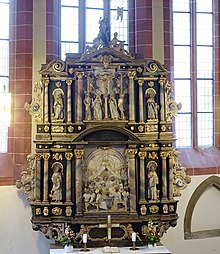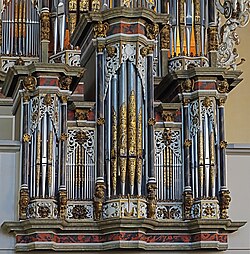Michaeliskirche (Erfurt)
The St. Michael's Church in Erfurt belongs to the Evangelical City Mission Erfurt, University Church of the University of Erfurt .
history
As early as 1183, a church was built at the current location, donated by the patricians Walter Kerlinger and Dietrich Hotermann as well as by Conrad Brun and Heinrich de Stalberg. At that time the church was on Via regia next to the Jewish quarter of Erfurt.
The lower part of the tower still comes from the first church. Between 1278 and 1290 - under the long-time pastor Heinrich Bauso - a Gothic hall without a choir was built, the core of today's church. In 1451 a north wing was added. The Trinity Chapel, founded by the pastor, professor of theology, multiple dean and rector of the university, Auxiliary Bishop Johannes Bonemilch von Lasphe, was completed around 1500.
Michaeliskirche has been the university church of the University of Erfurt since 1392 . The university's teaching buildings were directly opposite, including later the Collegium Maius .
Martin Luther , who studied in Erfurt between 1501 and 1505, regularly attended masses in Michaeliskirche. He preached here on October 21, 1522, after the first Protestant service had taken place in 1520. Bonemilch had ordained Luther a priest in 1507 (probably on April 3). Luther's friend Johannes Lang , the reformer of Erfurt, preached in Michaeliskirche from 1530 and was buried here in 1548.
In 1681 the pointed barrel was renewed. Additional overhaul work took place between 1742 and 1750. With the closure of the university in 1816, the Michaeliskirche became a parish church. In 1819 and 1820 it was redesigned in the neo-Gothic style.
Another extension was added on the west side in 1928. At the same time, the neo-Gothic interior was removed and replaced by the New Objectivity style. On February 9, 1945, an explosive bomb attack by the US Air Force on the old town of Erfurt caused severe damage to the roof and interior of the church, including the organ. The church could then be secured to such an extent that it did not become a ruin. A restoration between 1958 and 1960 allowed the church to be used again. Since 1973 the church has been administered by the Evangelical City Mission.
During the GDR era, in 1987, a highly acclaimed exhibition entitled “Transport for the city, for the city” was shown in the church , which was particularly directed against the planned expansion of the city ring through the old town. This was followed from 1987 to 1989 exhibitions "Creation Element Water" and "Creation Element Air", which dealt with the corresponding environmental problems in the GDR.
From 1989 to 1995 a renewed exterior and interior renovation of the church was carried out. Since Pentecost 2007, it has also been used as a service station for the Old Catholic Community of West Thuringia / Erfurt , which celebrates service there on the second and fourth Sunday of each month. In 2002 Michaeliskirche was reappointed a university church, and in 2007 the first university church service took place after the re-appointment.
In the church tower is the oldest bell in Erfurt, from 1380.
The Michaelis churchyard is “one of the most beautiful witnesses of late Gothic architecture”. In addition to 24 erect grave monuments from the 17th to 19th centuries from the floor of the Michaeliskirche, it also has two historical gravestones from the 15th and 16th centuries.
organ
After the organist and organ builder Balthasar Kühn had a fatal accident repairing the organ in 1648 , its condition deteriorated. Finally, the decision was made from the material of the old organ and the organ of aborted George Church by Ludwig Compenius to let build a new instrument. It was completed in 1652. The Michaeliskirche then became an important musical center.
In 1753 the Wagner brothers renewed and enlarged the organ in Erfurt's Michaeliskirche. The Wilhelm Rühlmann company from Merseburg built a new, pneumatic instrument in 1896, for which only parts of the old organ were reused. In 1928 the organ was moved to today's gallery and rebuilt again.
The Compenius organ could not avoid the bomb damage in 1945. From 1999 to 2000 it was reconstructed by the Rühle organ building workshop from Moritzburg. Large parts of the prospectus and the 27 painted prospectus pipes have been preserved from Compenius . She is on the Chorton mean- tuned.
|
|
|
|||||||||||||||||||||||||||||||||||||||
- Coupling : II / I ( sliding coupler ), I / P
literature
- Otto-Arend Mai: The Protestant Churches in Erfurt. 2nd edition, Evangelische Verlagsanstalt, Berlin 1989, ISBN 3-374-00936-0 , pp. 106-113.
- Christian Garbe: Michaeliskirche Erfurt. Art guide. Schnell and Steiner, Regensburg 2001, ISBN 3-7954-6235-5 .
Individual evidence
- ↑ a b Info on the University Church on ekmd.de
- ↑ Helmut Wolf: Erfurt in the air war 1939-1945 . Glaux-Verlag, Jena 2005. ISBN 3-931743-89-6 . P. 167
- ^ Compenius organ of the Michaeliskirche. Archived from the original on October 9, 2014 ; Retrieved October 9, 2014 .
- ^ Organ History , accessed April 10, 2020
- ↑ Erfurt, Germany (Thuringia) - Michaeliskirche. Retrieved July 29, 2016 .
Web links
- Church district Erfurt
- erfurt-tourismus.de
- Michaeliskirche on erfurt-web.de
- 360 ° tour of the Michaeliskirche Erfurt
Coordinates: 50 ° 58 ′ 45.6 ″ N , 11 ° 1 ′ 41.6 ″ E







